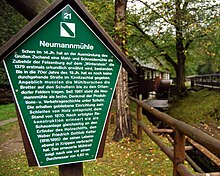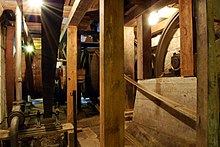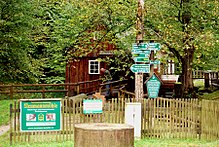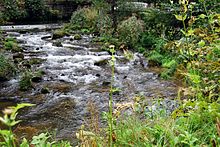Neumannmühle (Saxon Switzerland)
The Neumannmühle in Upper Saxon Switzerland , where the 6 km long Großer Zschand flows into the Kirnitzschtal , is a sawmill that was first mentioned in 1576 and has been owned by the Neumann family since 1791 . From 1870 it was also used for wood grinding (water power 15-18 HP).
Since June 8, 1996 it has been open to the public as a technical monument . The preserved equipment for sanding wood corresponds to the status of 1870. After a successful reconstruction, it also reminds of the inventor of the wood grinding, Friedrich Gottlob Keller, as a display system . The mill belongs to the district of Ottendorf in the city of Sebnitz .
history
The existence of a mill at the Neumannmühle site was first documented in 1576. In a directory of the Hohnstein office , two board mills are mentioned at the confluence of the Großer Zschand in the Kirnitzschtal, which are today's Neumannmühle and the neighboring Buschmühle . According to unproven information from Alfred Meiche , there is said to have been a mill at this point as early as the 14th century. Both mills were owned by farmers from Ottendorf.
In 1661 the mill belonged to the Ottendorf farmer Andreas Hickel. When he died in 1676, the mill was burdened with considerable debts. In the subsequent auction, his sons-in-law Christoph Michel from Lichtenhain and Michael Sturm from Saupsdorf acquired the Brettmühle. Around 1750, Sturm's heirs sold the mill to Georg Friedrich from Ottendorf. In 1791 his son Johann Christoph Friedrich sold the mill to his daughter Johanna Sophia, whose husband was the Bohemian miller Joseph Neumann. After the death of his first wife, who died in 1799, Neumann married Sophie Elisabeth Michel in 1801, a daughter of the Ottendorfer inheritance court owner . After Neumann's death in 1824, she in turn married the Stolpen miller Christian Traugott Herbrig four years later . In 1847, Christian Wilhelm Neumann, her son from her first marriage to Joseph Neumann, finally acquired the mill. In addition to the actual cutting mill, the mill also included the house, a barn and the associated land. There was also a meadow and a piece of field.
In 1872 the road through the Kirnitzschtal was built, which led through the middle of the mill yard. This made the transport of the sawn timber much easier, until the road was built, the miller's boys had to carry the cut timber on their shoulders up to the level of Ottendorf. This makes it the world's oldest original system that has been preserved. Christian Wilhelm Neumann took the improved transport connections as an opportunity to install a wood grinding system in the cutting mill, which he had probably acquired second-hand. The mill building was extended to include an extension. The plants were used to produce wood pulp until 1945. Otto Neumann, the last Neumann-Müller committed with his wife in the last days of the war suicide . The sawmill was not shut down until 1955.
As early as the 1960s, homeland security officers and experts interested in the history of technology began efforts to preserve the disused facility. With the help of the district of Sebnitz , the German Museum of Books and Writing in Leipzig and the VVB Zellstoff, Paper and Cardboard in Heidenau , the mill was opened in 1969 as a technical monument and museum.
After the facility could not be adequately maintained in the 1980s, the partially dilapidated facility has been extensively renovated and restored since the early 1990s. Since 1998 the Verein Schauanlage Neumannmühle eV has been taking care of the operation and maintenance of the facility.
Weir system
The weir at the Neumannmühle, once created for the rafting industry, was redesigned into a rough ramp in 2002 for the reintroduction of the salmon . It is of great importance for the population of fish and small organisms as well as for the preservation and restoration of the torrent character. The weir, which can now be surmounted by fish, adapts so well to the body of water that the jump in slope is almost invisible to the observer.
However, the nutrient-poor conditions in the Kirnitzsch limit the fish population, including that of brown trout. In sections it is suitable as a young fish and spawning habitat. However, fishing is prohibited in the national park area.
Tourist use
There is a large parking lot for hikers at the entrance to the Großer Zschand. In addition, the Neumannmühle bus stop is on bus route 241 (Pirna – Bad Schandau – Hinterhermsdorf), which is particularly popular on weekends. The restaurant and hiking hostel in the Neumannmühle is therefore often used by hikers, climbers and other tourists and serves as a starting point for hikes in the Großer Zschand and the rocky landscape of the Upper Saxon Switzerland.
The Neumannmühle is the stage destination of the 4th stage of the Malerweg coming from Altendorf past the Lichtenhain waterfall . The 5th stage leads from here to Schmilka . The Malerweg was voted Germany's most popular hiking stage in 2008. The 15 km long Flößersteig educational trail leads from the Neumannmühle to Bad Schandau along the Kirnitzsch to where it flows into the Elbe . More than 100 information boards on the Flößersteig provide information about the work of the rafters who once accompanied the tree trunks that were felled in the forests and rafted in the Kirnitzsch to the Elbe.
In addition to the old mill, guest rooms and sleeping bags in a mountain hut on the rock allow you to spend the night close to nature. Other mills, old like the timber rafting on the Kirnitzsch, complement romantic hikes. Steep rocks protrude from the valley along the access road and hiking trails and form the Kirnitzschklamm. National park guides organize half-day tours through this rocky landscape, which is loosened up by clearing rooms.
The Neumannmühle and the surrounding rocky area have been part of the Saxon Switzerland National Park since 1990 .
literature
- Alfred Meiche : A mill book. Of mills and millers in the work area of the mountain association for Saxon Switzerland. Yearbook of the Mountain Association for Saxon Switzerland , Dresden 1927
- Manfred Schober : The mills of Saxon Switzerland. Right Elbe area , monographs on Saxon-Bohemian Switzerland, Volume 2, Berg- & Naturverlag Rölke, Dresden 2009, ISBN 978-3-934514-24-9
Web links
Individual evidence
- ↑ a b c d Manfred Schober: The mills of Saxon Switzerland. Right-Elbe area , monographs on Saxon-Bohemian Switzerland, Volume 2, Berg- & Naturverlag Rölke, Dresden 2009, ISBN 978-3-934514-24-9 , pp. 75–79
Coordinates: 50 ° 55 '25 " N , 14 ° 17' 2.5" E




